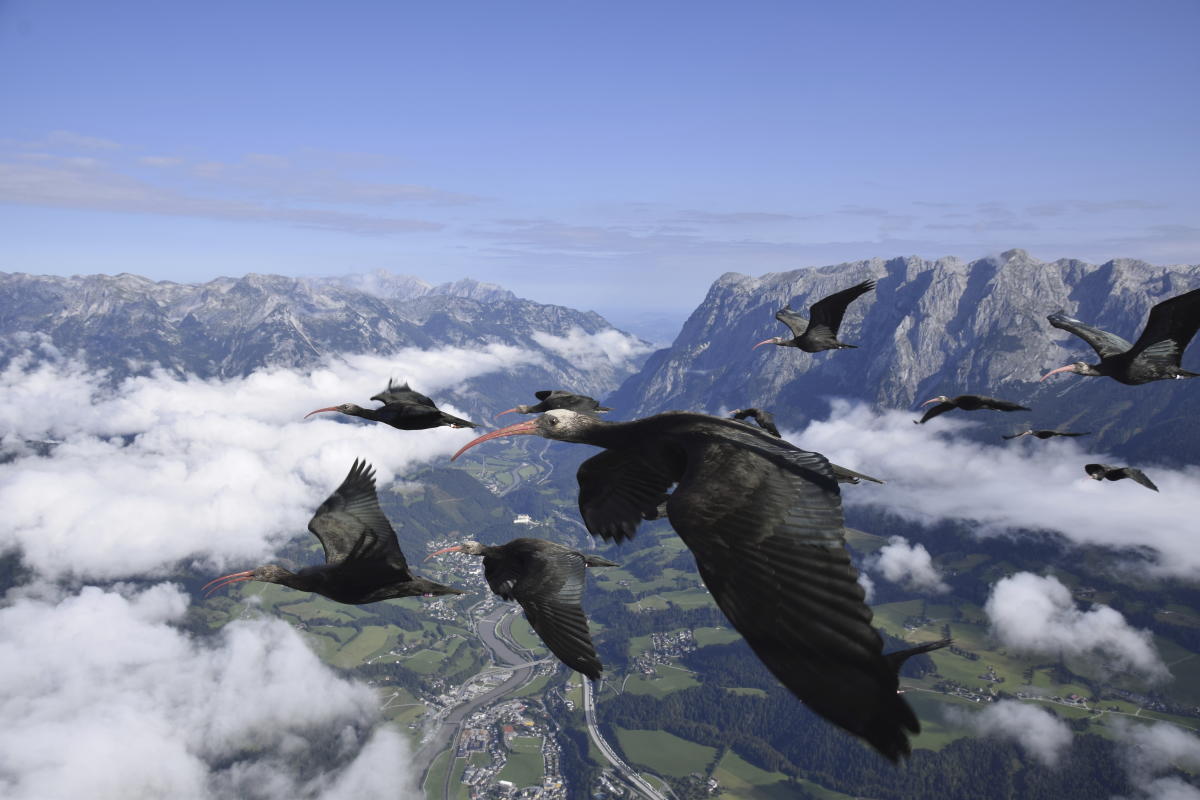PATERZELL, Germany (AP) — How do you teach a bird how and where to fly?
The iconic Northern Bald Ibis, which was nearly extinct in the 17th century, has been revived over the past two decades through breeding and rewilding efforts. But the birds—known for their distinctive black-and-iridescent green plumage, bald red head and long, curved bill—instinctively don’t know which direction to fly to migrate without the guidance of wild-born elders. So a team of scientists and conservationists stepped in as foster parents and flight instructors.
“We have to teach them the migration route,” says biologist Johannes Fritz.
The Northern Bald Ibis once flew over North Africa, the Arabian Peninsula and much of Europe, including southern German Bavaria. The migratory birds were also considered a delicacy and the bird, known in German as the Waldrapp, disappeared from Europe, although a few colonies survived elsewhere.
Thanks to the efforts of Fritz and the Waldrappteam, a conservation and research group from Austria, the population in Central Europe has been reduced from zero to almost 300 since their project began in 2002.
The achievement elevated the species from critically endangered to endangered and, according to Fritz, marks the first attempt to reintroduce an extinct migratory bird species found on the mainland.
But while Northern Bald Ibises still exhibit the natural urge to migrate, they do not know which direction to fly without the guidance of wild-born elders. The Waldrapp team’s early reintroduction attempts were largely unsuccessful because most birds, without learning the migration route, disappeared soon after their release. Instead of returning to suitable wintering areas such as Tuscany, Italy, they flew in different directions and eventually died.
So the Waldrapp team acted as foster parents and flight instructors for the Central European population, which consisted of descendants from multiple zoo colonies and was released into the wild in the hope of creating a migratory group. This year marks the 17th trip with human-led migration guides, and the second time they have been forced to take a new route to Spain due to climate change.
To prepare them for the journey, the chicks are removed from their breeding colonies when they are just a few days old and brought to an aviary guarded by the foster parents in the hope of “imprinting” — when the birds will bond with those people and eventually trust them along the migration route.
Barbara Steininger, a foster mom for the Waldrapp team, said she acts like “their bird mom.”
“We feed them, we clean them, we clean their nests. We take good care of them and make sure they are healthy birds,” she said. “But we also interact with them.”
Steininger and the other foster parents then sit on the back of an ultralight plane, waving and shouting words of encouragement through a megaphone as the plane flies through the air.
It’s a bizarre scene: The plane looks like a flying go-kart with a giant fan on the back and a yellow parachute keeping it aloft. Yet three dozen birds follow the contraption, piloted by Fritz, as it soars over alpine meadows and hills.
Fritz was inspired by “Father Goose” Bill Lishman, a naturalist who, beginning in 1988, taught Canada geese to fly alongside his ultralight aircraft. He later guided endangered whooping cranes through safe routes and founded the nonprofit Operation Migration. Lishman’s work inspired the 1996 film Fly Away Home, but features a young girl as the geese’s “mother.”
Like Lishman, Fritz and his team’s efforts have paid off. The first bird migrated back to Bavaria from Tuscany on its own in 2011. More birds have flown the more than 550-kilometer (342-mile) route each year, and the team hopes the Central European population will reach more than 350 birds and become self-sustaining by 2028.
But due to the effects of climate change, the Waldrapp are now migrating later in the season, forcing them to cross the Alps in colder, more dangerous weather – without the help of warm air currents, known as thermals, which rise upwards and help the birds fly without expending extra energy.
In response, the Waldrapp team started a new route in 2023, from Bavaria to Andalusia in southern Spain.
This year’s route is about 2,800 kilometers (1,740 miles) — about 300 kilometers (186 miles) longer than last year. Earlier this month, the team led 36 birds along a leg from an airfield in Paterzell, in Upper Bavaria, through clear blue skies and a tailwind that boosted their speed.
The entire journey to Spain can take up to 50 days, ending in early October. But Fritz says the effort is bigger than just the northern bald ibises: it’s about clearing the way for other endangered migratory birds to fly.
___
Dazio reported from Berlin.




